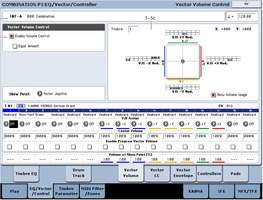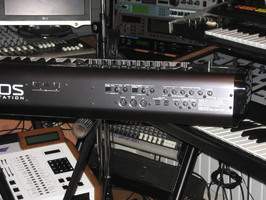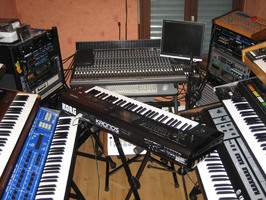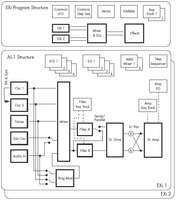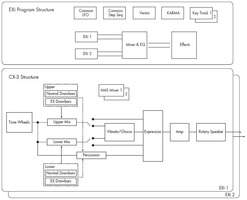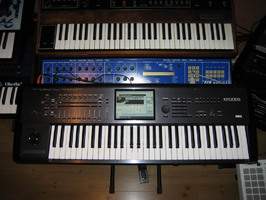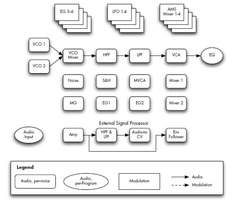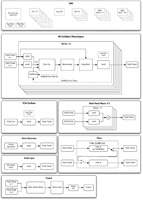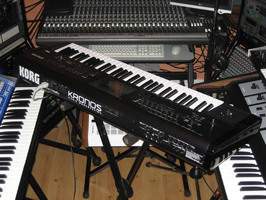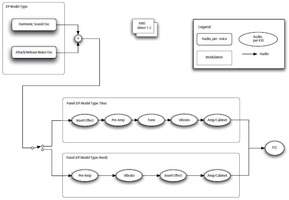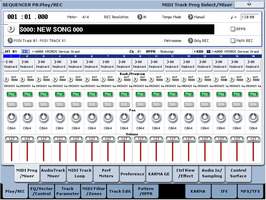Presented at the NAMM 2011 and already available since this summer, the Kronos represents a new step in the workstation market — a cruel world where every product becomes immediately obsolete as soon as the successor is launched. The Kronos is very innovative and comprehensive, but will it be able to break this fatal rule?
A Snap Shot: A Mini-Review


Sample Reader HD-1
Named HD-1, the first sound-synthesis engine is dedicated to playing back PCM samples. The HD-1 is a polyphonic instrument with up to 140 voices. The Kronos uses three different PCM-memory types: ROM (permanent memory), EXs (library of pre-loadabable samples; not to be confused with the Exi, which are the additional synthesis engines), and RAM (for user sampling). The ROM memory includes 314 MB of samples. The EXs expansions dedicated to the HD-1 engine (that is to say without the EXs6 and EXs7 expansions that are dedicated to the SGX-1 engine) use 2.6 GB of memory in total: 274 MB for the EXs1 (ROM Expansion), 361 MB for the EXs2 (Concert Grand Piano), 714 MB for the EXs3 (Brass & Woodwinds), 157 MB for the EXs4 (Vintage Keyboards), 458 MB for the EXs5 (Rom Expansion 2), 170 MB for the EXs8 (Rock Ambience Drums), and 472 MB for the EXs9 (Jazz Ambience Drums). The Kronos distinguishes itself from competitors by its low data compression without quality loss for EXs loading. This 10% reduction cannot be compared with the 1:2 or 1:3 ratios usually used by similar products. Note that the SGX-1 streaming engines do not use RAM sampling. The PCM banks provided were taken from the Oasys and its expansions, which are clearly superior to the M3 in terms of versatility and quality. The stereo strings sound good and are sorted in several stereo sections, while the vector joystick allows you to mix them gradually within certain given combinations. Voices are well conceived and sound good. They are sorted in different versions (classic, pop, jazz, with different vowels or articulations). You’ll also find fairly good guitars and basses extending the possibilities offered by the STR-1 engine. The quality of brass ensembles is a bit lower in the preloaded bank because of a slight lack of brilliance and expressiveness. You’ll find more dedicated additional banks that are more advanced and better conceived. The quality of solo instruments (clarinet, flutes, sax, trumpet, trombone…) is pretty good. Once again, it is superior to the M3 (more memory) although we noticed an obvious relationship and a common sound color. The sound of acoustic drums and percussions is very accurate and expressive: punch, nice timbres, multi-layer control via velocity, high-quality sample recording, sound versatility… equally useful for pop, rock, jazz, latin, and world music. In short, it’s perfect! Electronic drums are on the same level and are greatly enhanced by the fantastic multi-effects.

- HD-1 Strings01:59
- HD-1 Brass01:14
- HD-1 Choir02:49
Analog Modeling AL-1
The AL-1 engine is an analog-modeling synth with up to 80 voices of polyphony and without instance limits in multi mode. Compared to the MOSS engine in the previous Korg workstations, this new engine is jaw-dropping. Very fast envelopes generate very punchy lows, very interesting sound colors and a great versatility (round or acid basses, dark or bright pads, expressive leads)… The examples here provide an overview of the possibilities — who knows, maybe we put a real analog sound among them, can you tell where? Anyway, your opinion is always welcome, so leave your comments…

- AL-1 102:58
- AL-1 201:10
Organ Modeling CX-3
The CX-3 modeling is based on the eponymous Korg keyboard that is dedicated to organs that use mechanical tonewheels, like the Hammond B3. It includes its own effects, which are added to the 16 separate multi-effects. On the other hand, you can use “only” eight CX-3 instances in Combination mode, making it the most demanding engine in terms of DSP power; however, this ought to be more than enough. The maximum polyphony of the CX-3 engine is 200 notes, which seems reasonable enough as well! The modeling quality is good and musical, especially regarding different B3 programs with international standard settings. The behavior of the drawbars, the interaction between the wheels (leakage), the saturation, the behavior of the percussions, and the sound of the speaker are accurately reproduced. One of our examples includes a simple chord used to show you the evolution of the harmonic content when moving the nine front faders.

- CX-3 B300:45
- CX-3 B3 tirettes00:43
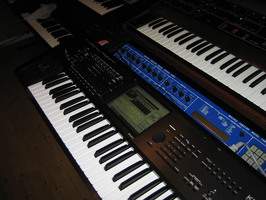
Strings Modeling STR-1
The STR-1 is a physical-modeling engine for plucked string instruments that allows you to create the sound of guitars, basses, harpsichords, harps, clavinets, e-pianos, bells, exotic instruments (sitar…), and many imaginary instruments. With this engine, maximum polyphony means 40 voices, and the engine can be replicated 16 times (instances). Listening to the presets, you’ll immediately feel the dynamics, the expressiveness and the musicality. The sound versatility is also very good, and you’ll get surprising results using extreme parameter values. You’ll find yourself switching between acoustic guitars (nylon and steel strings), acoustic or electric basses, Clavinets, and crazy sound creations (bells, drones, breath…).

- STR-1 101:20
- STR-1 201:39
- STR-1 301:24
Analog Modeling MS-20EX
The 5th engine included is the MS-20EX, a modeling of the MS-20 semi-modular analog synth with its characteristic (aggressive) filters. The vintage analog revival has made this typical sound very trendy in recent years. The first version of the virtual model was developed by Korg for its Legacy software suite several years ago. Korg also developed a hardware controller (a sort of mini MS-20 with patch cords) dedicated to the Legacy software. In the Kronos, the MS-20EX has a maximum polyphony of 40 voices. The modeling technology makes use of the same philosophy and graphics developed for the MS-20, but adds more parameters and modulations. Although we had no MS-20 for a direct comparison, we easily recognized its typical cutting and aggressive sound. Both serial filters whistle without restraint, syncs sound really dirty and you have modulations of all kinds at your disposal. The sound color is very different from the other analog modeling engines and there is no overlapping.

Analog Modeling PolysixEX
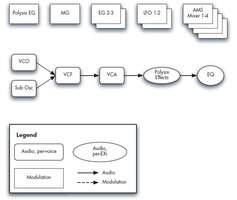 Well, we already presented more than half the synthesis engines, and we have still four to go! The next engine, called Polysix, is a modeling of the manufacturer’s famous vintage polyphonic synth. Like the MS-20EX, it was originally developed for the Legacy software suite several years ago. The PolysixEX offers 180 voices of polyphony and can be replicated up to 16 times in multitimbral mode. Although we had no real Polysix for a direct comparison, its characteristic sound was clearly recognizable. Dark pads, bright brasses, chord stabs, arpeggios… The global effects sound very good and give warmth to the oscillator.
Well, we already presented more than half the synthesis engines, and we have still four to go! The next engine, called Polysix, is a modeling of the manufacturer’s famous vintage polyphonic synth. Like the MS-20EX, it was originally developed for the Legacy software suite several years ago. The PolysixEX offers 180 voices of polyphony and can be replicated up to 16 times in multitimbral mode. Although we had no real Polysix for a direct comparison, its characteristic sound was clearly recognizable. Dark pads, bright brasses, chord stabs, arpeggios… The global effects sound very good and give warmth to the oscillator.

FM and Waveshaping MOD-7
After reviewing the PolysixEX, it’s time to go back to hardcore sound synthesis. Attention please! We are about to enter the mysteries of FM synthesis and waveshaping… it’s time for algorithms, multiplications, additions, subtractions, modular cords, harmonic distortion… Are you ready? Let’s go! The MOD-7 has a maximum polyphony of 52 voices — more than enough. The internal programs show the great dynamics, versatility and power of the engine: electric pianos, bells, percussions, but also wonderful hybrid pads, complex textures, crazy effects, extreme modulations… The MOD-7 is certainly the most powerful and interesting engine in the Kronos for synthesis freaks.
The MOD-7 can import directly (as SysEx messages) full banks of 32 programs each from the first DX7 generation. You can even import a batch of several banks. In other words, you can have several thousand programs immediately available at your fingertips. We tried this out with our DX7 and it’s perfect, even more so because there is no noise, especially in the low frequency range! By the way: can you tell if the e-piano at the beginning of our example is from the DX7 or from the Kronos? You’re opinion is welcome if it’s supported with relevant arguments…

Acoustic Pianos SGX-1
Let’s come back down to earth for brain cooling. Nothing could be better for this purpose than a wonderful acoustic piano sound — by far the best piano in a workstation, which can even compete with high-grade dedicated software solutions in terms of quality. The SGX-1 is a grand-piano modeling engine. Maximum polyphony reaches 100 dual voices in stereo (= 400 mono notes). Listen to the different internal acoustic piano programs and you’ll be impressed: very high-quality recording, full and resonant sound over the full frequency spectrum, powerful mids (often the most critical frequency range for workstation multisample pianos).

- SGX-1 Steinway 102:05
- SGX-1 Steinway 200:33
- SGX-1 Steinway 300:39
- SGX-1 C7 102:05
- SGX-1 C7 200:33
- SGX-1 C7 300:39
Vintage e-pianos EP-1
The EP-1 is the last synthesis engine of the Kronos. It models various vintage electric pianos like the Rhodes and the Wurlitzer. The maximum polyphony is 104 voices and you can use up to 18 instances of the EP-1 engine in multitimbral mode. Like the acoustic pianos, the authenticity and expressiveness of the Rhodes and Wurlitzer sounds will surely impress more than one. The sound restitution includes many details from attack to release. The integrated effects add even more authenticity (phaser, compressor, chorus…) and perfectly match the sound character you want. You’ll need only a few seconds to customize a program and you’ll find it hard to find any cons. Unlike most sampled e-pianos in other workstations, sound transitions are not audible across the full velocity range. You’ll be able to hear some few minor timbre changes if you listen very carefully, which serves to show that the modeling is based on multisampling.

- EP-1 MkI 101:23
- EP-1 MkI 201:23
- EP-1 W200A00:50
- EP-1 MkV01:23
- EP-1 MkII01:23
Combinations by 16
In the Kronos, you can group 16 programs in Combi mode. You can use any synthesis engine (synthesis and voice dynamic assignation), even if with some limitations in the number of instances. In most cases, the number of instances is more than enough. The internal memory includes 1,792 multitimbral combinations of up to 16 fully editable parts. As you load a combination, the LCD shows a virtual mixer with all 16 parts, which is a very convenient feature to get a comprehensive overview. You can change several parameters very quickly: program number, volume, pan, and you can adjust the EQ of the 16 parts, assign functions to controls, buttons and faders. Each part has plenty of parameters that be also adjusted: MIDI channel, playing mode (internal/external/both programs), oscillators activation, portamento, polyphony reserve, transpose/tuning, temperament, delay, wavetable sync, audio inputs routing for the supported EXi engines, MIDI filters and controllers (22 parameters), keyrange (with up and down fade), velocity range (also with up and down fades!), precise FX routing (inserts, sends, daisy chains, audio outs), plus advanced FX editing.

- Combi 101:27
- Combi 201:01
- Combi 3h01:55
- Combi 3l01:55
- Combi 401:36

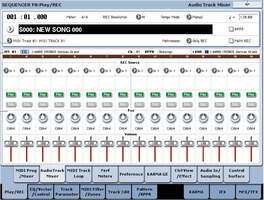
Conclusion
To sum it up, these are the pluses and minuses as I see it:


